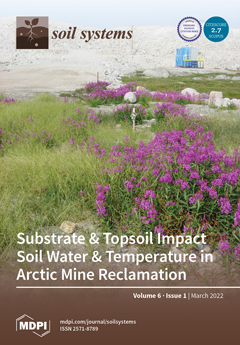In a model experiment, some adaptive characteristics, the bioaccumulation of toxic elements from technogenically-contaminated soils with polyelement anomalies, and rhizosphere microflora of Japanese millet,
Echinochloa frumentacea, were studied using biochemical, microbiological, physicochemical (AAS, ICP-MS, INAA), and metagenomic (16S rRNA) methods of analysis.
[...] Read more.
In a model experiment, some adaptive characteristics, the bioaccumulation of toxic elements from technogenically-contaminated soils with polyelement anomalies, and rhizosphere microflora of Japanese millet,
Echinochloa frumentacea, were studied using biochemical, microbiological, physicochemical (AAS, ICP-MS, INAA), and metagenomic (16S rRNA) methods of analysis. Good adaptive characteristics (the content of photosynthetic pigments, low molecular weight antioxidants) of
E. frumentacea grown on the soils of metallurgical enterprises were revealed. The toxic effect of soils with strong polyelement anomalies (multiple excesses of MPC for Cr, Ni, Zn, As, petroleum products) on biometric parameters and adaptive characteristics of Japanese millet were shown. The rhizosphere populations of
E. frumentacea grown in the background soil were characterized by the lowest taxonomic diversity compared to the rhizobiomes of plants grown in contaminated urban soils. The minimal number of all groups of microorganisms studied was noted in the soils, which contain the highest concentrations of both inorganic (heavy metals) and organic (oil products) pollutants. The taxonomic structure of the rhizospheric microbiomes of
E. frumentacea was characterized. It has been established that
E. frumentacea accumulated Mn, Co, As, and Cd from soils with polyelement pollution within the average values. V was accumulated mainly in the root system (transfer factor from roots to shoots 0.01–0.05) and its absorption mechanism is rhizofiltration. The removal of Zn by shoots of
E. frumentacea increased on soils where the content of the element exceeded the MPC and was 100–454 mg/kg of dry weight (168–508 g/ha). Analysis of the obtained data makes it possible to recommend
E. frumentacea for phytoremediation of soil from Cu and Zn at a low level of soil polyelement contamination using grass mixtures.
Full article





